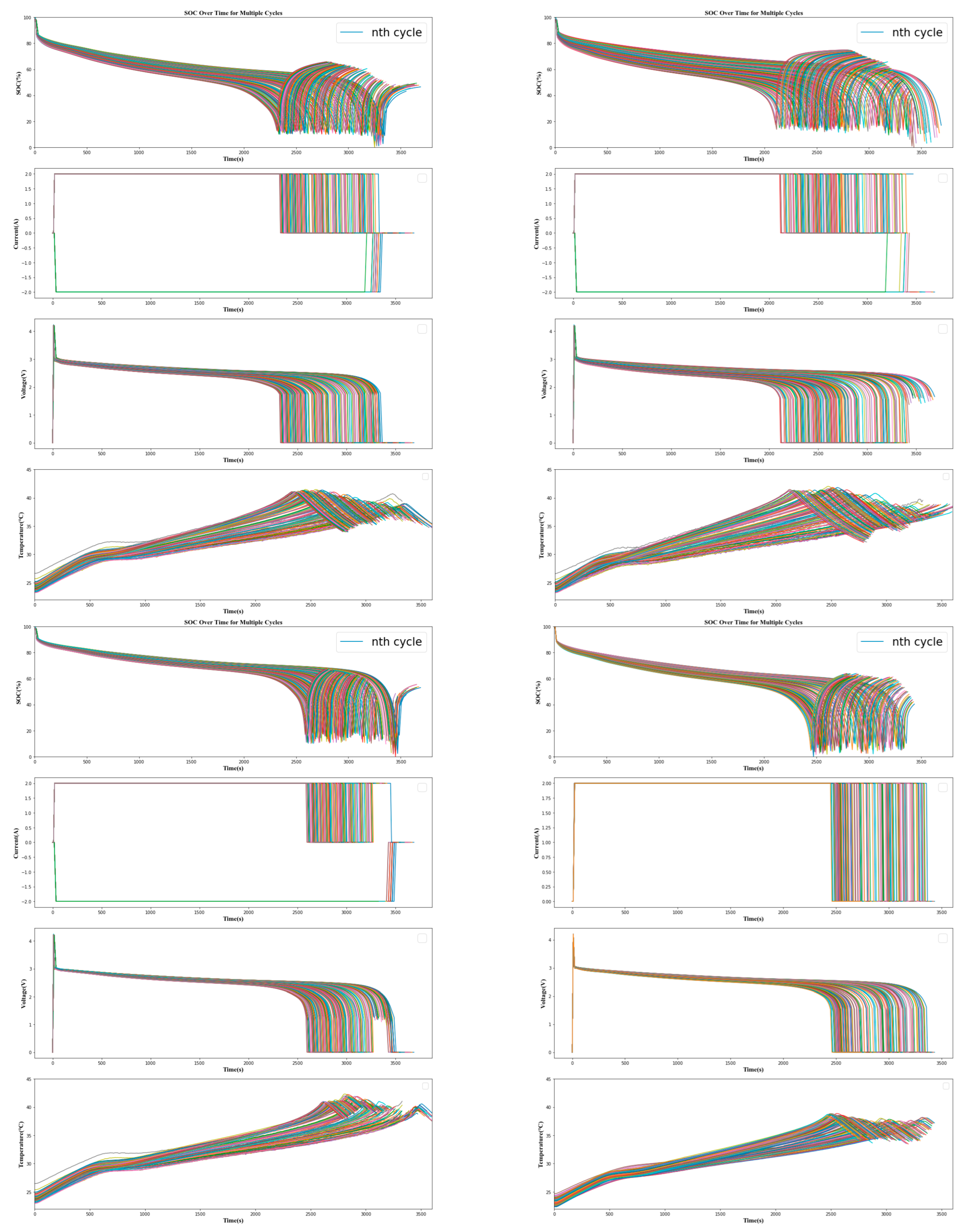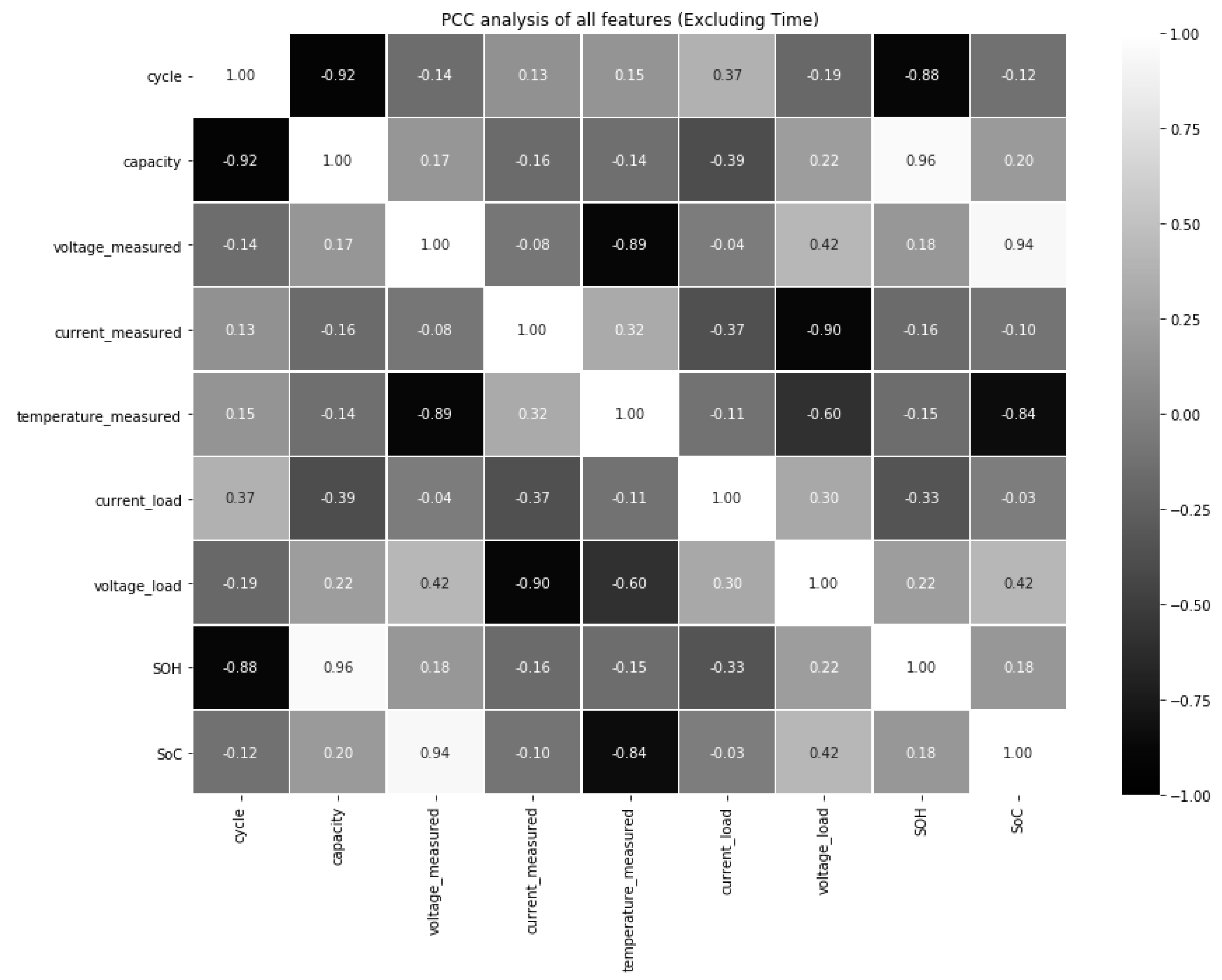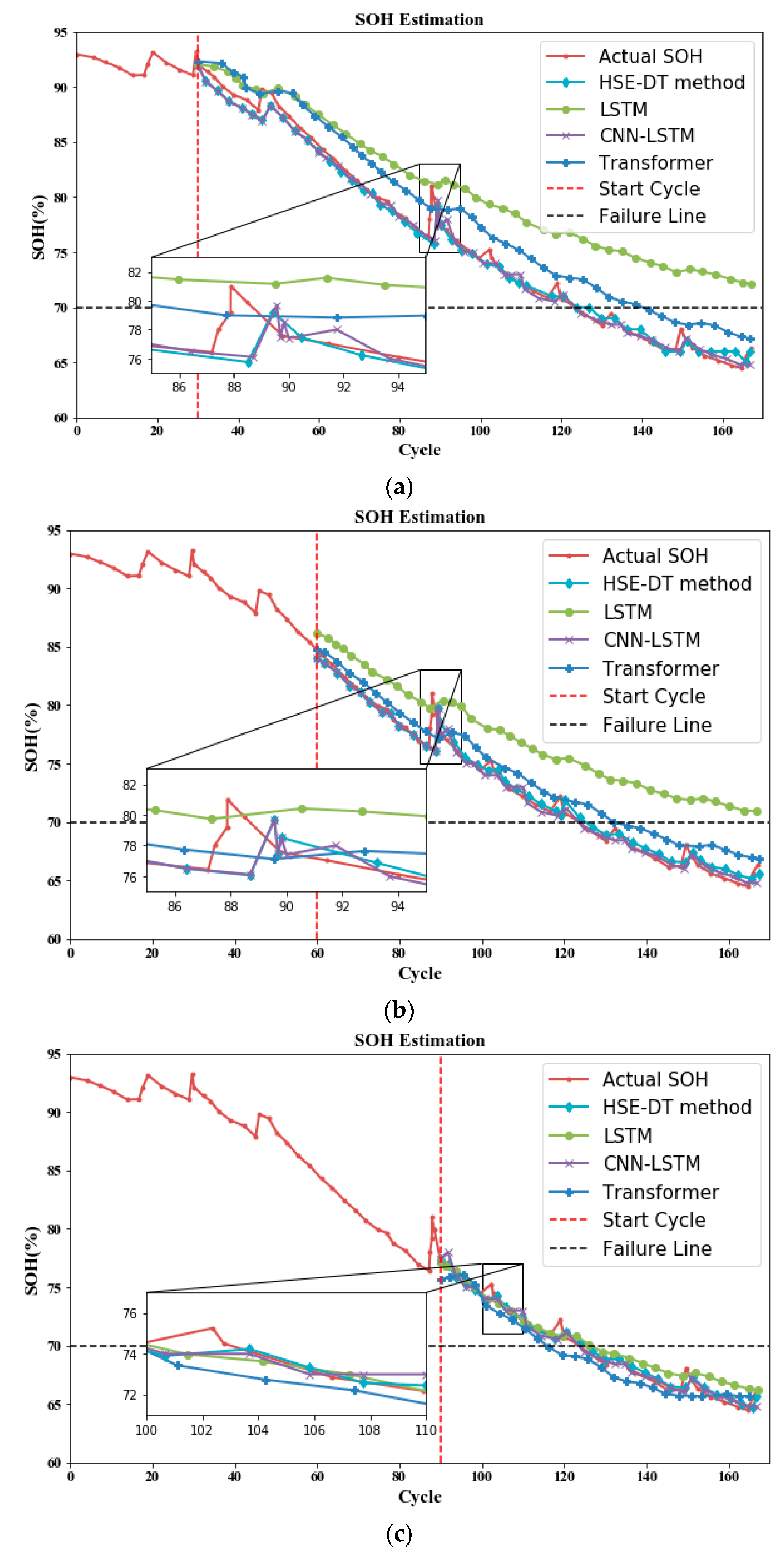A Hierarchical and Self-Evolving Digital Twin (HSE-DT) Method for Multi-Faceted Battery Situation Awareness Realisation
Abstract
:1. Introduction
2. Related Work
2.1. Battery Situation Awareness
2.1.1. Battery Monitoring
2.1.2. Battery State Estimation
2.2. Battery Digital Twin
2.3. Deep Learning in Battery Management
3. Proposed Method
3.1. Hierarchical and Self-Evolving Digital Twin (HSE-DT) Method
- Physical end: The actual battery system, with sensors to collect real-time data of parameters like current, voltage, temperature, and SOC, form this end. These sensors deliver the requisite data for state estimation.
- Cloud end: This end integrates and preprocesses data collected at the physical layer. This includes noise filtering, data normalising, and having consistency over various data resources.
- Digital end: The Digital Twin models that mimic the physical battery’s behaviour are served on this end. The models include electrochemical models, thermal models, and ageing models that are coupled to give a complete representation of the state of the battery. Real-time data are used to keep the models updated and accurate. On the digital end, advanced algorithms (CNN and Transformer models) are used to estimate SOC and SOH. These models use machine learning to analyse historical and real-time data to predict future states and detect anomalies.
- Output end: Critical outputs such as cell status monitoring, SOC estimation, and reliability recommendations are delivered at this end to help technicians make informed decisions.
- Decision Support end: The estimations and predictions are used to provide insights and recommendations at the topmost end. The user interfaces for stakeholders to interact with the Digital Twin, visualise data, and make informed decisions on battery management are part of this layer.
3.2. Battery Model
3.3. Transformer-CNN Model
3.4. Synergistic Interaction Within the Digital Twin
3.4.1. Multi-Faceted Integration
3.4.2. Feedback Mechanisms
3.4.3. Collaborative Analysis
3.5. The Self-Evolution Mechanism
4. Case Study
4.1. Data Description and Preprocessing
4.2. Performance Evaluation
4.3. Collective Situation Awareness
4.3.1. SOC Estimation
4.3.2. SOH Estimation
5. Conclusions and Future Work
Author Contributions
Funding
Data Availability Statement
Conflicts of Interest
References
- Che, Y.; Deng, Z.; Lin, X.; Hu, L.; Hu, X. Predictive battery health management with transfer learning and online model correction. IEEE Trans. Veh. Technol. 2021, 70, 1269–1277. [Google Scholar] [CrossRef]
- Hu, X.; Xu, L.; Lin, X.; Pecht, M. Battery lifetime prognostics. Joule 2020, 4, 310–346. [Google Scholar] [CrossRef]
- Ren, Z.; Wan, J.; Deng, P. Machine-learning-driven digital twin for lifecycle management of complex equipment. IEEE Trans. Emerg. Top. Comput. 2022, 10, 9–22. [Google Scholar] [CrossRef]
- Qin, Y.; Adams, S.; Yuen, C. Transfer learning-based state of charge estimation for lithium-ion battery at varying ambient temperatures. IEEE Trans. Ind. Inform. 2021, 17, 7304–7315. [Google Scholar] [CrossRef]
- Fan, J.; Zhang, X.; Zou, Y.; He, J. Multi-timescale Feature Extraction from Multi-sensor Data using Deep Neural Network for Battery State-of-charge and State-of-health Co-estimation. IEEE Trans. Transp. Electrif. 2023, 10, 5689–5702. [Google Scholar] [CrossRef]
- Zhou, N.; Zhao, X.; Han, B.; Li, P.; Wang, Z.; Fan, J. A novel quick and robust capacity estimation method for Li-ion battery cell combining information energy and singular value decomposition. J. Energy Storage 2022, 50, 104263. [Google Scholar] [CrossRef]
- Drath, R.; Horch, A. Industrie 4.0: Hit or hype?[industry forum]. IEEE Ind. Electron. Mag. 2014, 8, 56–58. [Google Scholar] [CrossRef]
- Dubarry, M.; Howey, D.; Wu, B. Enabling battery digital twins at the industrial scale. Joule 2023, 7, 1134–1144. [Google Scholar] [CrossRef]
- Grieves, M.W. Product lifecycle management: The new paradigm for enterprises. Int. J. Prod. Dev. 2005, 2, 71–84. [Google Scholar] [CrossRef]
- Tuegel, E.J.; Ingraffea, A.R.; Eason, T.G.; Spottswood, S.M. Reengineering aircraft structural life prediction using a digital twin. Int. J. Aerosp. Eng. 2011, 2011, 154798. [Google Scholar] [CrossRef]
- Semeraro, C.; Aljaghoub, H.; Abdelkareem, M.A.; Alami, A.H.; Dassisti, M.; Olabi, A. Guidelines for designing a digital twin for Li-ion battery: A reference methodology. Energy 2023, 284, 128699. [Google Scholar] [CrossRef]
- Naguib, M.; Kollmeyer, P.; Emadi, A. Lithium-ion battery pack robust state of charge estimation, cell inconsistency, and balancing. IEEE Access 2021, 9, 50570–50582. [Google Scholar] [CrossRef]
- Chen, C.; Fu, H.; Zheng, Y.; Tao, F.; Liu, Y. The advance of digital twin for predictive maintenance: The role and function of machine learning. J. Manuf. Syst. 2023, 71, 581–594. [Google Scholar] [CrossRef]
- Tang, H.; Wu, Y.; Cai, Y.; Wang, F.; Lin, Z.; Pei, Y. Design of power lithium battery management system based on digital twin. J. Energy Storage 2022, 47, 103679. [Google Scholar] [CrossRef]
- Qu, X.; Song, Y.; Liu, D.; Cui, X.; Peng, Y. Lithium-ion battery performance degradation evaluation in dynamic operating conditions based on a digital twin model. Microelectron. Reliab. 2020, 114, 113857. [Google Scholar] [CrossRef]
- Panwar, N.G.; Singh, S.; Garg, A.; Gupta, A.K.; Gao, L. Recent advancements in battery management system for Li-ion batteries of electric vehicles: Future role of digital twin, cyber-physical systems, battery swapping technology, and nondestructive testing. Energy Technol. 2021, 9, 2000984. [Google Scholar] [CrossRef]
- Zhu, J.; Cui, X.; Ni, W. Model predictive control based control strategy for battery energy storage system integrated power plant meeting deep load peak shaving demand. J. Energy Storage 2022, 46, 103811. [Google Scholar] [CrossRef]
- Naseri, F.; Gil, S.; Barbu, C.; Çetkin, E.; Yarimca, G.; Jensen, A.; Larsen, P.G.; Gomes, C. Digital twin of electric vehicle battery systems: Comprehensive review of the use cases, requirements, and platforms. Renew. Sustain. Energy Rev. 2023, 179, 113280. [Google Scholar] [CrossRef]
- Wang, Y.; Xu, R.; Zhou, C.; Kang, X.; Chen, Z. Digital twin and cloud-side-end collaboration for intelligent battery management system. J. Manuf. Syst. 2022, 62, 124–134. [Google Scholar] [CrossRef]
- Li, W.; Rentemeister, M.; Badeda, J.; Jöst, D.; Schulte, D.; Sauer, D.U. Digital twin for battery systems: Cloud battery management system with online state-of-charge and state-of-health estimation. J. Energy Storage 2020, 30, 101557. [Google Scholar] [CrossRef]
- Wang, C.; Xu, M.; Zhang, Q.; Feng, J.; Jiang, R.; Wei, Y.; Liu, Y. Parameters identification of Thevenin model for lithium-ion batteries using self-adaptive Particle Swarm Optimization Differential Evolution algorithm to estimate state of charge. J. Energy Storage 2021, 44, 103244. [Google Scholar] [CrossRef]
- Qin, J.; Liu, Y.; Grosvenor, R. Multi-source data analytics for AM energy consumption prediction. Adv. Eng. Inform. 2018, 38, 840–850. [Google Scholar] [CrossRef]
- Chen, C.; Liu, Y.; Sun, X.; Di Cairano-Gilfedder, C.; Titmus, S. An integrated deep learning-based approach for automobile maintenance prediction with GIS data. Reliab. Eng. Syst. Saf. 2021, 216, 107919. [Google Scholar] [CrossRef]
- Plett, G.L. Extended Kalman filtering for battery management systems of LiPB-based HEV battery packs: Part 3. State and parameter estimation. J. Power Sources 2004, 134, 277–292. [Google Scholar] [CrossRef]
- Khaneghah, M.Z.; Alzayed, M.; Chaoui, H. Fault detection and diagnosis of the electric motor drive and battery system of electric vehicles. Machines 2023, 11, 713. [Google Scholar] [CrossRef]
- Ci, S.; He, H.; Kang, C.; Yang, Y. Building digital battery system via energy digitization for sustainable 5G power feeding. IEEE Wirel. Commun. 2020, 27, 148–154. [Google Scholar] [CrossRef]
- Lin, J.; Liu, X.; Li, S.; Zhang, C.; Yang, S. A review on recent progress, challenges and perspective of battery thermal management system. Int. J. Heat Mass Transf. 2021, 167, 120834. [Google Scholar] [CrossRef]
- He, Y.; Liu, X.; Zhang, C.; Chen, Z. A new model for State-of-Charge (SOC) estimation for high-power Li-ion batteries. Appl. Energy 2013, 101, 808–814. [Google Scholar] [CrossRef]
- Hu, Y.; Lin, L.; Zhang, Y.; Wang, Z.L. Replacing a battery by a nanogenerator with 20 V output. Adv. Mater. 2012, 24, 110–114. [Google Scholar] [CrossRef] [PubMed]
- Fan, J.; Fan, J.; Liu, F.; Qu, J.; Li, R. A novel machine learning method based approach for Li-ion battery prognostic and health management. IEEE Access 2019, 7, 160043–160061. [Google Scholar] [CrossRef]
- Zhou, M.; Yan, J.; Feng, D. Digital twin framework and its application to power grid online analysis. CSEE J. Power Energy Syst. 2019, 5, 391–398. [Google Scholar]
- Rae, C.; Bradley, F. Energy autonomy in sustainable communities—A review of key issues. Renew. Sustain. Energy Rev. 2012, 16, 6497–6506. [Google Scholar] [CrossRef]
- Wu, B.; Widanage, W.D.; Yang, S.; Liu, X. Battery digital twins: Perspectives on the fusion of models, data and artificial intelligence for smart battery management systems. Energy AI 2020, 1, 100016. [Google Scholar] [CrossRef]
- Botta, A.; De Donato, W.; Persico, V.; Pescapé, A. Integration of cloud computing and internet of things: A survey. Future Gener. Comput. Syst. 2016, 56, 684–700. [Google Scholar] [CrossRef]
- Sancarlos, A.; Cameron, M.; Abel, A.; Cueto, E.; Duval, J.-L.; Chinesta, F. From ROM of electrochemistry to AI-based battery digital and hybrid twin. Arch. Comput. Methods Eng. 2021, 28, 979–1015. [Google Scholar] [CrossRef]
- Merkle, L.; Pöthig, M.; Schmid, F. Estimate e-Golf Battery State Using Diagnostic Data and a Digital Twin. Batteries 2021, 7, 15. [Google Scholar] [CrossRef]
- Qin, Y.; Arunan, A.; Yuen, C. Digital twin for real-time Li-ion battery state of health estimation with partially discharged cycling data. IEEE Trans. Ind. Inform. 2023, 19, 7247–7257. [Google Scholar] [CrossRef]
- Reniers, J.M.; Howey, D.A. Digital twin of a MWh-scale grid battery system for efficiency and degradation analysis. Appl. Energy 2023, 336, 120774. [Google Scholar] [CrossRef]
- Qu, J.; Liu, F.; Ma, Y.; Fan, J. A neural-network-based method for RUL prediction and SOH monitoring of lithium-ion battery. IEEE Access 2019, 7, 87178–87191. [Google Scholar] [CrossRef]
- Feng, X.; Weng, C.; He, X.; Han, X.; Lu, L.; Ren, D.; Ouyang, M. Online state-of-health estimation for Li-ion battery using partial charging segment based on support vector machine. IEEE Trans. Veh. Technol. 2019, 68, 8583–8592. [Google Scholar] [CrossRef]
- Dong, G.; Han, W.; Wang, Y. Dynamic Bayesian network-based lithium-ion battery health prognosis for electric vehicles. IEEE Trans. Ind. Electron. 2020, 68, 10949–10958. [Google Scholar] [CrossRef]
- Li, Y.; Zou, C.; Berecibar, M.; Nanini-Maury, E.; Chan, J.C.-W.; Van den Bossche, P.; Van Mierlo, J.; Omar, N. Random forest regression for online capacity estimation of lithium-ion batteries. Appl. Energy 2018, 232, 197–210. [Google Scholar] [CrossRef]
- Meng, J.; Cai, L.; Luo, G.; Stroe, D.-I.; Teodorescu, R. Lithium-ion battery state of health estimation with short-term current pulse test and support vector machine. Microelectron. Reliab. 2018, 88, 1216–1220. [Google Scholar] [CrossRef]
- Lin, M.; Yan, C.; Meng, J.; Wang, W.; Wu, J. Lithium-ion batteries health prognosis via differential thermal capacity with simulated annealing and support vector regression. Energy 2022, 250, 123829. [Google Scholar] [CrossRef]
- Urolagin, S.; Sharma, N.; Datta, T.K. A combined architecture of multivariate LSTM with Mahalanobis and Z-Score transformations for oil price forecasting. Energy 2021, 231, 120963. [Google Scholar] [CrossRef]
- Cheng, G.; Wang, X.; He, Y. Remaining useful life and state of health prediction for lithium batteries based on empirical mode decomposition and a long and short memory neural network. Energy 2021, 232, 121022. [Google Scholar] [CrossRef]
- Han, T.; Wang, Z.; Meng, H. End-to-end capacity estimation of Lithium-ion batteries with an enhanced long short-term memory network considering domain adaptation. J. Power Sources 2022, 520, 230823. [Google Scholar] [CrossRef]
- Tan, Y.; Zhao, G. Transfer learning with long short-term memory network for state-of-health prediction of lithium-ion batteries. IEEE Trans. Ind. Electron. 2019, 67, 8723–8731. [Google Scholar] [CrossRef]
- Ma, Y.; Shan, C.; Gao, J.; Chen, H. A novel method for state of health estimation of lithium-ion batteries based on improved LSTM and health indicators extraction. Energy 2022, 251, 123973. [Google Scholar] [CrossRef]
- Li, P.; Zhang, Z.; Xiong, Q.; Ding, B.; Hou, J.; Luo, D.; Rong, Y.; Li, S. State-of-health estimation and remaining useful life prediction for the lithium-ion battery based on a variant long short term memory neural network. J. Power Sources 2020, 459, 228069. [Google Scholar] [CrossRef]
- Zhou, H.; Zhang, Y.; Yang, L.; Liu, Q.; Yan, K.; Du, Y. Short-term photovoltaic power forecasting based on long short term memory neural network and attention mechanism. IEEE Access 2019, 7, 78063–78074. [Google Scholar] [CrossRef]
- Hu, J.; Zheng, W. Multistage attention network for multivariate time series prediction. Neurocomputing 2020, 383, 122–137. [Google Scholar] [CrossRef]
- Wang, W.; Wang, J.; Tian, J.; Lu, J.; Xiong, R. Application of digital twin in smart battery management systems. Chin. J. Mech. Eng. 2021, 34, 57. [Google Scholar] [CrossRef]
- Du, X.; Meng, J.; Zhang, Y.; Huang, X.; Wang, S.; Liu, P.; Liu, T. An information appraisal procedure: Endows reliable online parameter identification to lithium-ion battery model. IEEE Trans. Ind. Electron. 2021, 69, 5889–5899. [Google Scholar] [CrossRef]
- Kong, J.-z.; Yang, F.; Zhang, X.; Pan, E.; Peng, Z.; Wang, D. Voltage-temperature health feature extraction to improve prognostics and health management of lithium-ion batteries. Energy 2021, 223, 120114. [Google Scholar] [CrossRef]
- Jebli, I.; Belouadha, F.-Z.; Kabbaj, M.I.; Tilioua, A. Prediction of solar energy guided by pearson correlation using machine learning. Energy 2021, 224, 120109. [Google Scholar] [CrossRef]
- Benesty, J.; Chen, J.; Huang, Y. On the Importance of the Pearson Correlation Coefficient in Noise Reduction. IEEE Trans. Audio Speech Lang. Process. 2008, 16, 757–765. [Google Scholar] [CrossRef]







| Methods | RMSE | MAE |
|---|---|---|
| HSE-DT | 0.009 | 0.007 |
| LSTM | 0.032 | 0.025 |
| CNN-LSTM | 0.011 | 0.085 |
| Transformer | 0.017 | 0.013 |
| Dataset | Models | MAE | MAPE | RMSE | R2 |
|---|---|---|---|---|---|
| B0005(90th) | Transformer-CNN | 0.0024 | 0.0031 | 0.0029 | 0.9901 |
| LSTM | 0.0043 | 0.0624 | 0.0071 | 0.8981 | |
| CNN-LSTM | 0.0029 | 0.0160 | 0.0041 | 0.9721 | |
| Transformer | 0.0035 | 0.0740 | 0.0045 | 0.9610 | |
| B0006(90th) | Transformer-CNN | 0.0024 | 0.0038 | 0.0028 | 0.9938 |
| LSTM | 0.0105 | 0.0575 | 0.0135 | 0.8425 | |
| CNN-LSTM | 0.0030 | 0.0168 | 0.0045 | 0.9848 | |
| Transformer | 0.0035 | 0.0752 | 0.0051 | 0.9816 | |
| B0007(90th) | Transformer-CNN | 0.0018 | 0.0050 | 0.0022 | 0.9908 |
| LSTM | 0.0037 | 0.0520 | 0.0056 | 0.9215 | |
| CNN-LSTM | 0.0017 | 0.0335 | 0.0025 | 0.9869 | |
| Transformer | 0.0021 | 0.0711 | 0.0029 | 0.9809 | |
| B0018(90th) | Transformer-CNN | 0.0024 | 0.0038 | 0.0029 | 0.9981 |
| LSTM | 0.0569 | 0.0768 | 0.0666 | 0.8491 | |
| CNN-LSTM | 0.0204 | 0.0394 | 0.0283 | 0.9330 | |
| Transformer | 0.0425 | 0.0712 | 0.0498 | 0.7885 |
Disclaimer/Publisher’s Note: The statements, opinions and data contained in all publications are solely those of the individual author(s) and contributor(s) and not of MDPI and/or the editor(s). MDPI and/or the editor(s) disclaim responsibility for any injury to people or property resulting from any ideas, methods, instructions or products referred to in the content. |
© 2025 by the authors. Licensee MDPI, Basel, Switzerland. This article is an open access article distributed under the terms and conditions of the Creative Commons Attribution (CC BY) license (https://creativecommons.org/licenses/by/4.0/).
Share and Cite
Zhao, K.; Liu, Y.; Zhou, Y.; Ming, W.; Wu, J. A Hierarchical and Self-Evolving Digital Twin (HSE-DT) Method for Multi-Faceted Battery Situation Awareness Realisation. Machines 2025, 13, 175. https://doi.org/10.3390/machines13030175
Zhao K, Liu Y, Zhou Y, Ming W, Wu J. A Hierarchical and Self-Evolving Digital Twin (HSE-DT) Method for Multi-Faceted Battery Situation Awareness Realisation. Machines. 2025; 13(3):175. https://doi.org/10.3390/machines13030175
Chicago/Turabian StyleZhao, Kai, Ying Liu, Yue Zhou, Wenlong Ming, and Jianzhong Wu. 2025. "A Hierarchical and Self-Evolving Digital Twin (HSE-DT) Method for Multi-Faceted Battery Situation Awareness Realisation" Machines 13, no. 3: 175. https://doi.org/10.3390/machines13030175
APA StyleZhao, K., Liu, Y., Zhou, Y., Ming, W., & Wu, J. (2025). A Hierarchical and Self-Evolving Digital Twin (HSE-DT) Method for Multi-Faceted Battery Situation Awareness Realisation. Machines, 13(3), 175. https://doi.org/10.3390/machines13030175








